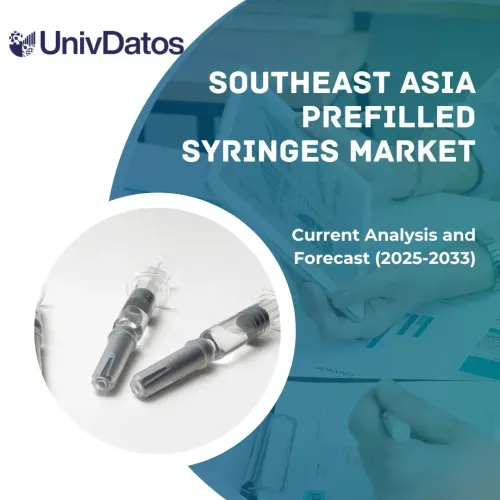- Home
- About Us
- Industry
- Services
- Reading
- Contact Us
Chronic Obstructive Pulmonary Disease Market Insight, Epidemiology, & Forecast (2024-2032)
Emphasis on Marketed Therapies (Symbicort, Dupixent, Dalirespt, and Others); Emerging Therapies (Itepekimab, Fasenra, Ensifentrine, and Others) and Country
 Chronic Obstructive Pulmonary Disease Market Size & Forecast
Chronic Obstructive Pulmonary Disease Market Size & Forecast
The Chronic Obstructive Pulmonary Disease Market was valued at approximately USD 13 Billion in 2023 and is expected to grow at a strong CAGR of around ~5% during the forecast period (2024-2032) owing to the robust pipeline activity, advancements in genetic research, and patient-centered drug development.
Chronic Obstructive Pulmonary Disease Market Analysis
The Chronic Obstructive Pulmonary Disease (COPD) market is characterized by significant growth and evolving treatment landscapes, driven by the increasing global prevalence of the disease and advancements in therapeutic options. COPD, which includes chronic bronchitis and emphysema, leads to persistent respiratory symptoms and airflow limitation, making it a major cause of morbidity and mortality worldwide.
The global aging population is a significant driver of the COPD market. As people age, the risk of developing COPD increases due to cumulative exposure to risk factors such as smoking and environmental pollutants. According to the World Health Organization (WHO), the number of people aged 60 years and older is expected to double by 2050, reaching about 2.1 billion, thereby expanding the potential patient pool for COPD.
Chronic Obstructive Pulmonary Disease: Disease Overview
- Cause: Smoking is the primary risk factor for COPD, and despite public health efforts to reduce smoking prevalence, it remains a widespread habit, particularly in developing countries. The WHO estimates that there are over 1.3 billion tobacco users worldwide, and this persistent smoking habit continues to drive COPD incidence rates.
- Environmental Factors: Increased exposure to air pollution, occupational dust, and chemicals is another significant driver of the COPD market. Urbanization and industrialization in emerging economies contribute to higher exposure levels, exacerbating the incidence of COPD.
In Chronic Obstructive Pulmonary Disease, adoption, and implementation efforts have led to significant disease management and patient care advancements. Regulatory approvals for innovative therapies, such as exon-skipping drugs and gene therapies, provided patients with access to treatments targeting the underlying genetic causes of the disease.
Chronic Obstructive Pulmonary Disease: Diagnosis
Diagnosing Chronic Obstructive Pulmonary Disease (COPD) involves a comprehensive approach that includes patient history, physical examinations, and specific diagnostic tests to confirm the presence and severity of the disease. One of the primary diagnostic tools is spirometry, a non-invasive test that measures lung function by assessing the volume of air a patient can exhale after a deep breath and the speed at which the air can be expelled. Specifically, a post-bronchodilator Forced Expiratory Volume in one second (FEV1)/Forced Vital Capacity (FVC) ratio of less than 0.70 indicates persistent airflow limitation, confirming a COPD diagnosis.
In addition to spirometry, other diagnostic methods include chest X-rays and computed tomography (CT) scans to visualize the lungs and rule out other conditions such as heart failure or lung cancer that may present similar symptoms. Arterial blood gas analysis is another important test that measures the levels of oxygen and carbon dioxide in the blood, providing insights into the severity of COPD and the presence of respiratory failure.
Chronic Obstructive Pulmonary Disease: Treatment
Chronic Obstructive Pulmonary Disease (COPD) is a progressive respiratory condition characterized by airflow obstruction and breathing difficulties. The primary goals of COPD treatment are to relieve symptoms, improve quality of life, and slow disease progression. A cornerstone of managing COPD is the use of bronchodilators, which help relax the muscles around the airways, making breathing easier. These medications are available in short-acting forms for quick relief and long-acting forms for sustained control. Inhaled corticosteroids may also be prescribed, particularly for patients with frequent exacerbations, to reduce inflammation and prevent flare-ups. Combination inhalers that include both bronchodilators and corticosteroids can be especially effective. For some patients, phosphodiesterase-4 inhibitors might be recommended to decrease inflammation and relax the airways. Oxygen therapy is another critical component, particularly for those with severe COPD and low blood oxygen levels. Long-term oxygen therapy can improve survival rates and overall well-being.
In addition to pharmacological treatments, non-pharmacological interventions play a vital role in COPD management. Pulmonary rehabilitation programs, which combine exercise training, nutritional advice, and education, are highly effective in enhancing patients’ physical and emotional health. These programs help improve exercise tolerance, reduce symptoms, and decrease the frequency and severity of exacerbations. Smoking cessation is paramount, as smoking is the leading cause of COPD; cessation can significantly slow disease progression and improve treatment outcomes. Vaccinations against influenza and pneumococcal pneumonia are also crucial to prevent respiratory infections that can exacerbate COPD. In severe cases or when medical management is insufficient, surgical options such as lung volume reduction surgery, bullectomy, or even lung transplantation may be considered. Emerging treatments, including regenerative medicine and novel pharmacological agents, are under investigation and hold promise for future management of COPD. Ultimately, a comprehensive, multidisciplinary approach tailored to the individual patient’s needs is essential for optimizing COPD treatment and improving patient outcomes.
Chronic Obstructive Pulmonary Disease: Therapeutic Strategies
Bronchodilators:
- Short-acting: Provide quick relief of symptoms by relaxing airway muscles.
- Long-acting: Offer sustained control of symptoms, improve lung function, and reduce exacerbations.
Inhaled Corticosteroids:
- Used to reduce airway inflammation, particularly in patients with frequent exacerbations.
Combination Inhalers:
- Include both bronchodilators and corticosteroids for enhanced effectiveness.
Phosphodiesterase-4 Inhibitors:
- Decrease inflammation and relax the airways, particularly for severe COPD cases.
Mucolytics:
- Help to thin mucus, making it easier to cough up and clear from the airways.
Antibiotics:
- Used during exacerbations caused by bacterial infections.
Chronic Obstructive Pulmonary Disease: Epidemiology
The report on Chronic Obstructive Pulmonary Disease epidemiology includes both historical and forecasted data, segmented by various parameters. It covers:
- Total Prevalent Population of Chronic Obstructive Pulmonary Disease
- Age-specific Prevalent Population of Chronic Obstructive Pulmonary Disease
- Gender Specific Prevalent Population of Chronic Obstructive Pulmonary Disease
The analysis spans the 7MM market, including the United States, EU5 countries (Germany, France, Italy, Spain, and the United Kingdom), and Japan, from 2024 to 2032.
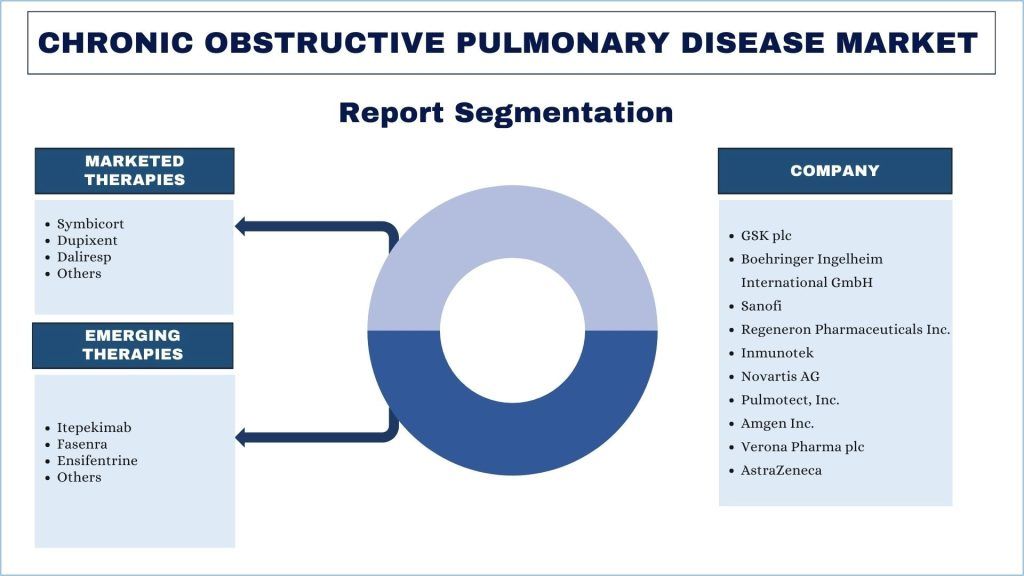
Major Insights:
This section provides an overview of the Chronic Obstructive Pulmonary Disease (COPD) epidemiology across the 7MM regions.
- COPD affects approximately 16 million people in the U.S., with millions more likely undiagnosed. It is the third leading cause of death in the country.
- France has an estimated 3.5 million COPD patients. The disease is more prevalent among the elderly and smokers.
- Smoking is the primary cause, with additional risks from occupational hazards and air pollution.
- COPD places a considerable economic burden on healthcare systems due to high treatment costs, hospital admissions, and long-term management needs.
The United States holds the dominant share of the market in 2023.
The U.S. market for Chronic Obstructive Pulmonary Disease (COPD) is substantial, reflecting the high prevalence and significant impact of this condition on public health and the healthcare system. Approximately 16 million Americans have been diagnosed with COPD, with many more potentially undiagnosed, making it the third leading cause of death in the country. The primary driver of COPD in the U.S. is smoking, although other factors such as air pollution, occupational exposures, and genetic predispositions also contribute. The economic burden of COPD is considerable, with direct healthcare costs exceeding USD 32 billion annually, alongside indirect costs from lost productivity and disability. The market is characterized by a robust demand for pharmacological treatments, including bronchodilators, inhaled corticosteroids, and combination inhalers, aimed at managing symptoms and preventing exacerbations. Additionally, non-pharmacological interventions such as pulmonary rehabilitation and oxygen therapy are integral components of COPD management. The U.S. market is also witnessing significant investments in research and development, focusing on innovative treatments and personalized medicine approaches to improve patient outcomes. Public health initiatives aimed at smoking cessation and early diagnosis are critical in addressing the growing burden of COPD in the U.S.
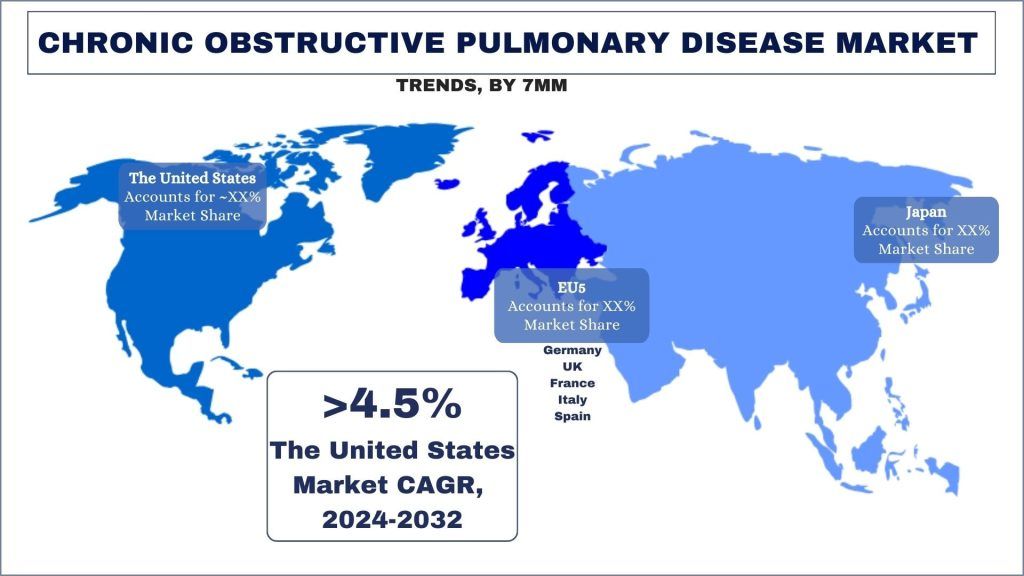
Chronic Obstructive Pulmonary Disease: Drug Profile
The Chronic Obstructive Pulmonary Disease (COPD) Drug Profile provides a comprehensive overview of the therapeutic landscape for COPD. This section covers the various treatment options available, including current standard-of-care therapies, emerging drugs in the pipeline, and innovative treatments under development. Each section of drugs delves into the mechanisms of action, clinical trial progress, regulatory status, and potential impact of these drugs on the management of COPD. By exploring both existing and upcoming therapies, this section aims to offer a detailed understanding of the evolving treatment paradigm for Chronic Obstructive Pulmonary Disease.
Chronic Obstructive Pulmonary Disease: Marketed Therapies
Symbicort (Budesonide and Formoterol): AstraZeneca
Description
Symbicort is a prescription medication that combines two active ingredients, budesonide and formoterol fumarate dihydrate, in a single inhaler. Budesonide is an inhaled corticosteroid (ICS) that helps reduce inflammation in the airways, while formoterol is a long-acting beta-agonist (LABA) that relaxes the muscles around the airways, making it easier to breathe. This dual-action mechanism makes Symbicort effective in managing both Chronic Obstructive Pulmonary Disease (COPD) and asthma.
Detailed Product Information Included in the Report…
Chronic Obstructive Pulmonary Disease Industry Overview
The Chronic Obstructive Pulmonary Disease market is competitive, with several 7MM and international market players. The key players are adopting different growth strategies to enhance their market presence, such as partnerships, agreements, collaborations, new product launches, geographical expansions, and mergers and acquisitions. Some of the major players operating in the market are AstraZeneca; GSK plc; Boehringer Ingelheim International GmbH; Sanofi; Regeneron Pharmaceuticals Inc.; Inmunotek; Novartis AG; Pulmotect, Inc; Amgen Inc.; and Verona Pharma plc.
Chronic Obstructive Pulmonary Disease Market News
In February 2024, Sanofi and Regeneron have been working together on the development of Dupixent®, which has shown significant reductions in COPD exacerbations in a pivotal Phase 3 trial.
Chronic Obstructive Pulmonary Disease Market Report Coverage
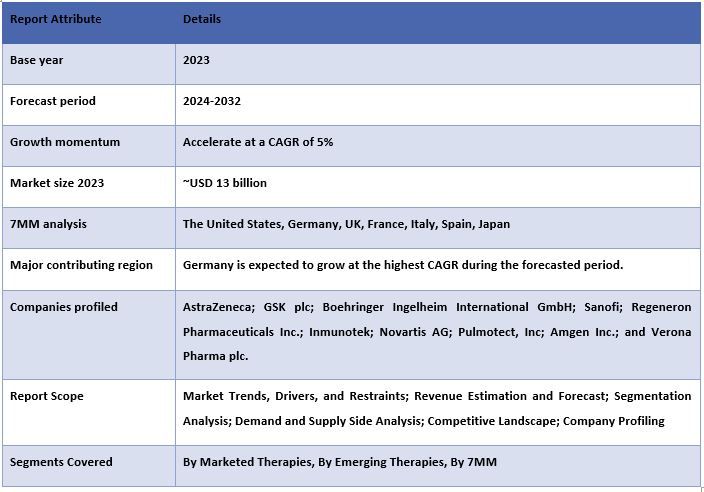
Reasons to buy this report:
- The study includes market sizing and forecasting analysis validated by authenticated key industry experts.
- The report presents a quick review of overall industry performance at one glance.
- The report covers an in-depth analysis of prominent industry peers with a primary focus on key business financials, product portfolios, expansion strategies, and recent developments.
- Detailed examination of drivers, restraints, key trends, and opportunities prevailing in the industry.
- The study comprehensively covers the market across different segments.
- Deep dive regional level analysis of the industry.
Customization Options:
The global Chronic Obstructive Pulmonary Disease market can further be customized as per the requirement or any other market segment. Besides this, UMI understands that you may have your own business needs, hence feel free to connect with us to get a report that completely suits your requirements.
Table of Content
Research Methodology for the Chronic Obstructive Pulmonary Disease Market – Epidemiology & Market Forecast (2024-32)
Analyzing the historical market, estimating the current market, and forecasting the future market of the Chronic Obstructive Pulmonary Disease market were the three major steps undertaken to create and analyze the total prevalent population of Chronic Obstructive Pulmonary Disease and adoption of Chronic Obstructive Pulmonary Disease therapeutics in 7 Major Markets. Exhaustive secondary research was conducted to collect the historical market numbers and prevalence of diseases and estimate the current market size. Secondly, to validate these insights, numerous findings and assumptions were taken into consideration. Moreover, exhaustive primary interviews were also conducted with industry experts across the value chain of the global Chronic Obstructive Pulmonary Disease market. The assumption and validation of market numbers through primary interviews, we employed a top-down/bottom-up approach to forecasting the patient population and complete market size. Thereafter, market breakdown and data triangulation methods were adopted to estimate and analyze the market size of segments and sub-segments of the industry. Detailed methodology is explained below:
Analysis of Historical Market Size
Step 1: In-Depth Study of Secondary Sources:
An extensive secondary study was conducted to gather data on prevalence/incidence rates, diagnostic rates, treatment rates, historical market sizes, etc., for the Chronic Obstructive Pulmonary Disease market. This involved utilizing internal sources such as annual reports & financial statements, performance presentations, press releases, etc., and external sources including journals, news & articles, government publications, competitor publications, sector reports, third-party database, and other credible publications. This step ensured a robust understanding of the market’s epidemiology and historical context.
Step 2: Exhaustive Epidemiological Investigation
To enhance the accuracy of epidemiological data, we employed a multi-step approach:
- Literature Review: An exhaustive review of peer-reviewed journals, clinical trial data, and epidemiological studies to establish baseline prevalence and incidence rates.
- Database Analysis: Utilization of specialized databases such as WHO, CDC, and national health registries to corroborate findings and refine prevalence and incidence estimates.
- Cross-Validation: Cross-referencing data from multiple sources to ensure consistency and reliability of epidemiological estimates.
Step 3: Market Segmentation:
After obtaining the historical market size of the Chronic Obstructive Pulmonary Disease market, we conducted a detailed secondary analysis to gather historical market insights and share for different segments, sub-segments, and products for major regions. The report includes major segments such as marketed therapies, emerging therapies, and regions. Further country-level analyses were conducted to evaluate the overall adoption of testing models in that region.
Step 4: Factor Analysis:
After acquiring the historical data of different segments and sub-segments, we conducted a detailed factor analysis to estimate the current scenario of the Chronic Obstructive Pulmonary Disease market. Further, we conducted factor analysis using dependent and independent variables such as Marketed Therapies, Emerging Therapies, and country (7MM) of the Chronic Obstructive Pulmonary Disease market. A thorough analysis was conducted for demand and supply-side scenarios considering top partnerships, mergers and acquisitions, business expansion, and product launches in the Chronic Obstructive Pulmonary Disease market sector.
Current Market Size Estimate & Forecast
Current Market Sizing: Based on actionable insights from the above 3 steps, we arrived at the current market size, key players in the Chronic Obstructive Pulmonary Disease market, and market shares of the segments. All the required percentage shares split, and market breakdowns were determined using the above-mentioned secondary approach and were verified through primary interviews.
Estimation & Forecasting: For market estimation and forecast, weights were assigned to different factors including drivers & trends, restraints, and opportunities available for the stakeholders. After analyzing these factors, relevant forecasting techniques i.e., the top-down/bottom-up approach were applied to arrive at the market forecast for 2032 for different segments and sub-segments across the 7 major markets. The research methodology adopted to estimate the market size encompasses:
- The industry’s market size, in terms of revenue (USD) and the prevalent population and available treatments for Chronic Obstructive Pulmonary Disease, and adoption rate of the Chronic Obstructive Pulmonary Disease market across the 7 major markets domestically
- All percentage shares, splits, and breakdowns of market segments and sub-segments
- Key players in the global Chronic Obstructive Pulmonary Disease market in terms of products offered. Also, the growth strategies adopted by these players to compete in the fast-growing market.
Market Size and Share Validation
Primary Research: In-depth interviews were conducted with the Key Opinion Leaders (KOLs) including Top Level Executives (CXO/VPs, Sales Head, Marketing Head, Operational Head, Regional Head, Country Head, etc.) across major regions. In Addition to this, interviews with healthcare professionals including physicians, surgeons, and specialist doctors were also conducted to get epidemiology-specific insights. Primary research findings were then summarized, and statistical analysis was performed to prove the stated hypothesis. Inputs from primary research were consolidated with secondary findings, hence turning information into actionable insights.
Split of Primary Participants in Different Regions
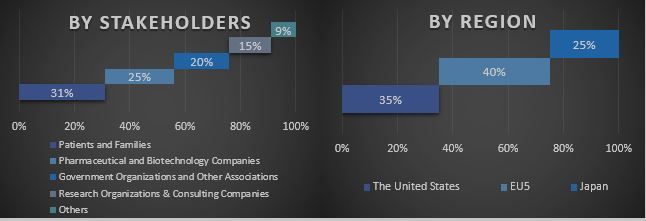
Market Engineering
The data triangulation technique was employed to complete the overall market estimation and arrive at precise statistical numbers for each segment and sub-segment of the global Chronic Obstructive Pulmonary Disease market. After studying various parameters and trends in the marketed therapies, emerging therapies, and regions of the global Chronic Obstructive Pulmonary Disease market, data was split into several segments and sub-segments.
The main objective of the Global Chronic Obstructive Pulmonary Disease Market Study
The current & future market trends of the global Chronic Obstructive Pulmonary Disease market were pinpointed in the study. Investors can gain strategic insights to base their discretion for investments on the qualitative and quantitative analysis performed in the study. Current and future market trends determined the overall attractiveness of the market at a regional level, providing a platform for the industrial participant to exploit the untapped market to benefit from a first-mover advantage. Other quantitative goals of the studies include:
- Analyze the current and forecast market size of the Chronic Obstructive Pulmonary Disease market in terms of value (USD). Also, analyze the current and forecast market size of different segments and sub-segments.
- Accurately estimate the prevalence and incidence rates of Chronic Obstructive Pulmonary Disease and understand the diagnostic and treatment rates, aiding in the identification of unmet medical needs and potential market opportunities.
- Segments in the study include areas of the marketed therapies, emerging therapies, and regions.
- Define and analysis of the regulatory framework for the Chronic Obstructive Pulmonary Disease
- Analyze the current and forecast market size of the Chronic Obstructive Pulmonary Disease market for the 7 major Markets.
- Major countries of regions studied in the report include the United States, Germany, the UK, France, Italy, Spain, and Japan.
- Company profiles of the Chronic Obstructive Pulmonary Disease market and the growth strategies adopted by the market players to sustain in the fast-growing market.
- To conduct country-level analyses to evaluate the adoption of testing models and therapies in specific regions.
Frequently Asked Questions FAQs
Q1: What is Chronic Obstructive Pulmonary Disease?
Q2: What is the Chronic Obstructive Pulmonary Disease market's current market size and growth potential?
Q3: What are the driving factors for the growth of the Chronic Obstructive Pulmonary Disease market?
Q4: What is the overall Chronic Obstructive Pulmonary Disease epidemiology scenario in 7MM?
Q5: Which country will dominate the Chronic Obstructive Pulmonary Disease market?
Related Reports
Customers who bought this item also bought








